Goal: Relate representations
Source: 283-342 Graph Ex(x)
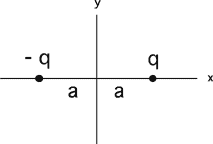
We have a charge configuration
(shown at the right). Which graph is the plot of Ex(x), the
x component of the electric field, as you move along the
x-axis?
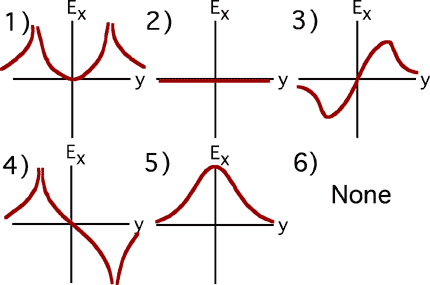
Goal: Relate representations
Source: 283-342 Graph Ex(x)

We have a charge configuration
(shown at the right). Which graph is the plot of Ex(x), the
x component of the electric field, as you move along the
x-axis?

Goal: Reason regarding electric fields
Source: 283-11, E at origin due to charged rods
For which of the configuration(s) below does the total electric field
vector at the origin have non-zero components in both the x and y
directions?
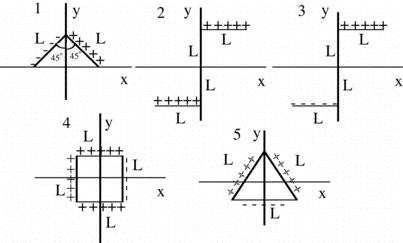
(6) Only situation 3 meets the condition. A good exercise is to have
students draw the contribution to the field at the origin due to each
rod. The contributions should have the correct relative size and
direction.
Goal: Reason regarding electric fields
Source: 283 –
Charge, Q, is at the origin. Points A-E are positions where other
charges may be present. Etotal at point F is non-zero and
points in the +i direction. Which of the following situations
could account for this?
- Another charge is present at position
A.- Two other charges are present at C & D.
- Two other
charges are present at D & B.- Two other charges are present at
E & A.
(2) Only a charge at C can counter the y component of the field of Q at
F. A charge at B or D can then create a field at F that points in the i
direction.
Goal: Reason regarding electric fields
Source: 283-10, E at origin due to charged rods
All of the configurations shown below consist of charged rods of the
same length L. The magnitude of the total charge is also the same for
each rod. The total charge in each rod is distributed uniformly.
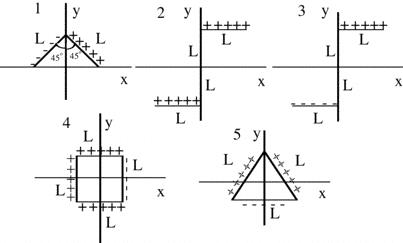
For which
configuration(s) is the electric field vector at the origin in the
positive x direction?
(4) Because they are given lots of examples involving point charges,
spheres and rings, students often miss the fact that there are many
situations for which the direction of the field can be deduced even
though determining the value or formal expression for the field is way
beyond them.
Goal: Hone the concept of torque
Source: UMPERG-ctqpe130
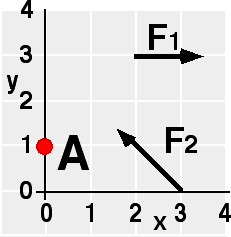
Given
F1 = 6N, and F2 = 8N, what is the total torque
about point A?
(6) Many students use the origin rather than the point A. This provides
the opportunity to stress that torque is found with respect to a
specified point. Students using the right hand rule incorrectly may
answer #2.
Goal: Reasoning with electric forces
Source: UMPERG-A2LEM5
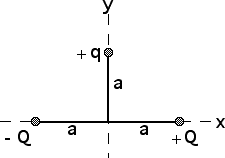
What is the direction of the electrical force on the charge q shown in
the diagram?
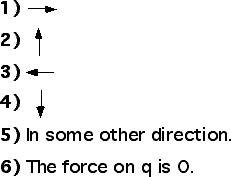
(3)
Goal: Hone the concept of torque
Source: UMPERG-ctqpe131
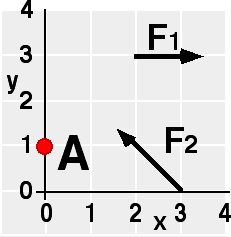
Which of the following statements is true about this situation?
(3) Many students realize that there is at least one point, the
intersection of the lines of action of the two forces, having zero
torque. A drawing is usually sufficient to convince students that there
is an entire line along which the torque is zero.
Goal: Hone the vector nature of velocity.
Source: UMPERG-ctqpe142

A
child is standing at the rim of a rotating disk holding a rock. The
disk rotates without friction. The rock is thrown in the RADIAL
direction at the instant shown, which of the indicated paths most nearly
represents the path of the rock as seen from above the disk?
(4) is the correct path if the rock is thrown radially.
Once thrown the components of the velocity of the rock lying in a
horizontal plane are constant so the rock will have a path which is a
straight line.
Identify a coordinate frame. What are the components of the velocity
vector immediately after the rock is thrown?
What is the radial component of the velocity if the rock follows path
(2)?
Is it possible to throw the rock in such a way that the rock follows
path (5)?
This item should be compared to 63.
Goal: Understanding the first law.
Source: UMPERG-ctqpe120
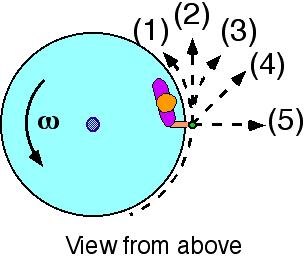
A
child is standing at the rim of a rotating disk holding a rock. The
disk rotates without friction. If the rock is dropped at the instant
shown, which of the indicated paths most nearly represents the path of
the rock as seen from above the disk?
(2) is the correct path if the rock is simply dropped. Some students
selecting answer (3) may be viewing the rock from the child’s
perspective. Some students indicating choice (5) may interpret this
path as ‘straight down’.
This question is similar to others which seek to reveal student
perceptions about path persistence. It is a slightly different context
from the purely horizontal case of a ball rolling on a horizontal
surface around an semicircular section of hoop.
What path would the child see?
What is the velocity of the rock just before it is dropped? just after?
What would the path of the rock have been if the child continued to hold
it?
There are a variety of demonstrations that can be done as followup to
this question. It is important that students perceive the similarity
between the demonstration context and the problem situation.
Goal: Hone the vector nature of force and identify all the forces.
Source: UMPERG
A small ball is released from rest at position A and rolls down a
vertical circular track under the influence of gravity as depicted
below.
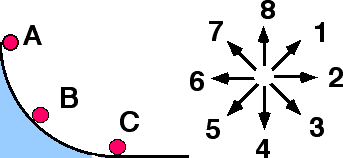
When the ball reaches position B, which of the indicated directions most
nearly corresponds to the direction of the net force on the ball?
Enter (9) if the direction cannot be determined.
(9) The net force is the sum of the forces acting on the ball. If the
ball rolls along the track there is a normal force, a friction force and
a gravitational force being exerted on the ball. Although a best answer
can be determined it would require a good understanding of dynamics,
energy, and circular motion to achieve and we assume the student is
addressing this question before all these elements are in place. [The
actual answer is (2) but few students are able to appreciate that
without much thought.]
To become adept at identifying forces, students should consider a wide
array of situations, even if the situations are too complex for them to
fully analyze. To determine the direction of the net force students
need to be able to judge the relative sizes of forces.
What forces are being exerted on the ball? What are the directions of
these forces? What are the relative sizes of the different forces?
Consider a block sliding down an incline at 450? How does
the block on an incline compare to the ball on the curved track? What
are some similarities and differences?
Commentary:
Answer
(6) Students should recognize that the field goes singular at the
charges. The only graphs doing that, #1 and #4, are eliminated because
the x-component of the field must be negative everywhere between the two
charges. Have students sketch the graph.